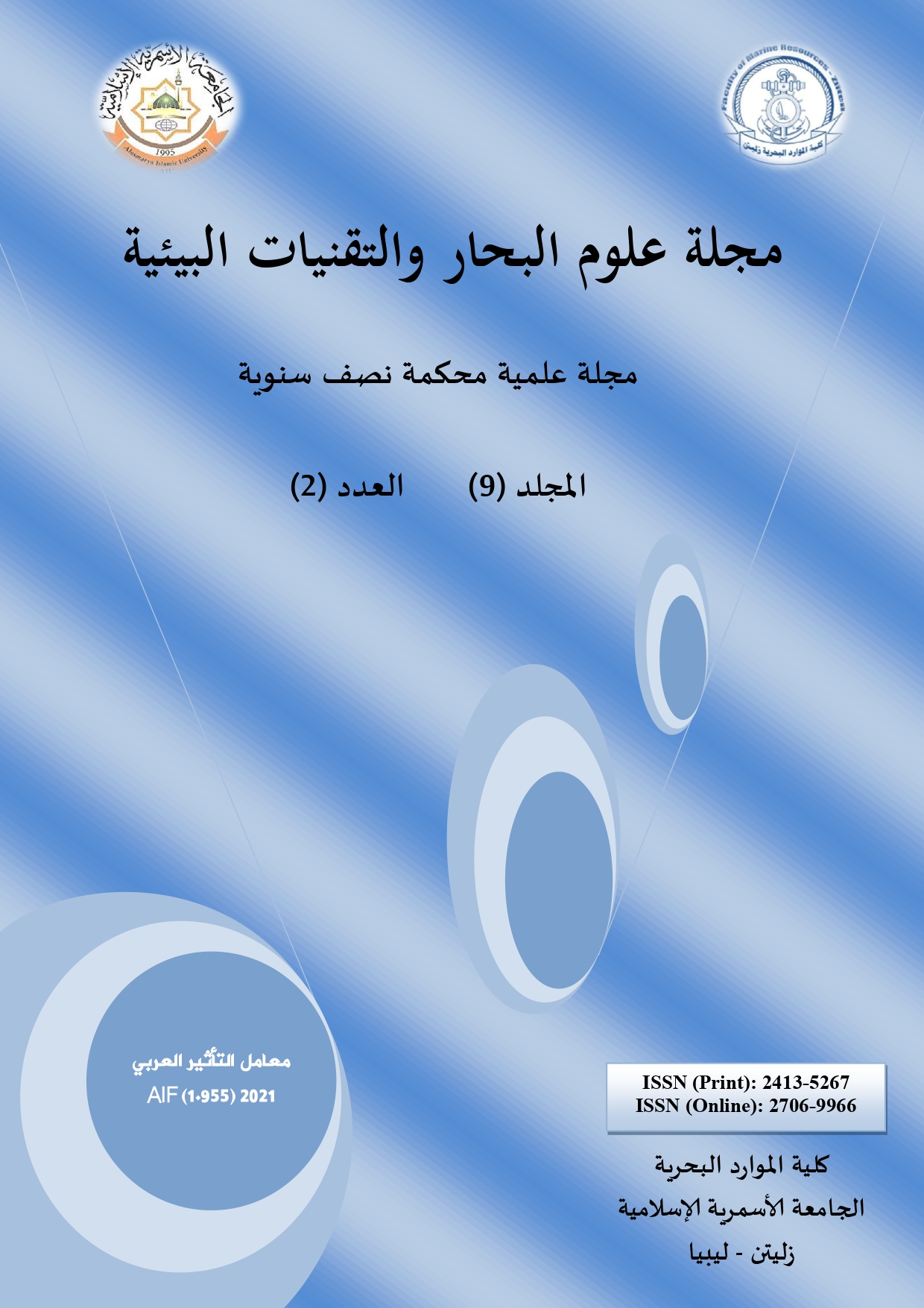تحديد ظروف القطع المثلى في عمليات الخراطة الطولية على عمر أداة القطع لتحقيق أفضل معدل إنتاج وأقل كلفة
DOI:
https://doi.org/10.59743/jmset.v9i2.163الكلمات المفتاحية:
أنوفا ANOVA، تاقوتشي Taguchi، أداة القطع، عملية الخراطةالملخص
في هذا البحث تمت دراسة تأثير ظروف القطع (سرعة القطع، معدل التغذية، عمق القطع) على عمر أداة القطع في عمليات الخراطة الطولية لعينة من حديد متوسط الكربون (C35) بطول) 1200 مم) وقطر (100 مم) باستخدام آلة خراطة تقليدية وأداة قطع كربيدية (P10). صممت التجارب على أساس ثلاثة مستويات لكل من سرعة القطع والتغذية وعمق القطع باستخدام طريقة تاقوشي لتقليل عدد التجارب، واستخدم برنامج (Minetab 16) لتحقيق ذلك. وتم تحديد مستوى أهمية ظروف القطع على عمر أداة القطع عن طريق تحليل التباين (ANOVA). تم تحديد ظروف القطع المثلى وفقا لمعايير اقتصادية وإنتاجية كالتكلفة الكلية الأدنى ومعدل الإنتاج الأقصى. وأظهرت النتائج أن الزيادة في سرعة القطع تؤدي إلى انخفاض في عمر الأداة، وكذلك الزيادة في معدل التغذية وعمق القطع. ومن جدول تحليل (ANOVA) يتضح أن عامل سرعة القطع هو الأكثر تأثيراً على عمر أداة القطع بنسبة (91.9%)، ويليه معدل التغذية بنسبة (6%)، بينما كان تأثير عمق القطع الأقل تأثيراً على عمر أداة القطع بنسبة (1.2%). وتم أيضاً تقدير التكلفة ومعدل الإنتاج المتمثل في عدد الأجزاء المصنعة لكل أداة قطع في التجارب العملية التي أجريت، وعلى ضوء هذا التقدير تم اختيار ظروف القطع المثلى للحصول على أفضل عمر أداة قطع إنتاجيا واقتصاديا، وأوضحت النتائج أن ظروف القطع المثلى التي تم الحصول عليها لتحسين عمر أداة القطع في عملية الخراطة كانت عند سرعة قطع (46 متر/دقيقة) ومعدل تغذية (0.1 مم/لفة) وعمق قطع (3مم).
المراجع
Ahsan, K. B., Mazid, A. M., Clegg, R. E., & Pang, G. K. H. (2012). Study on carbide cutting tool life using various cutting speeds for α-β Ti-alloy machining. Journal of achievements in materials and manufacturing engineering, 55(2), 601-606.
Amaitik, S. M., Taşgin, T. T., & Kilic, S. E. (2006). Tool-life modelling of carbide and ceramic cutting tools using multi-linear regression analysis. Proceedings of the Institution of Mechanical Engineers, Part B: Journal of Engineering Manufacture, 220(2), 129-136. DOI: https://doi.org/10.1243/09544054JEM416
Cetin, M. H., Ozcelik, B., Kuram, E., & Demirbas, E. (2011). Evaluation of vegetable based cutting fluids with extreme pressure and cutting parameters in turning of AISI 304L by Taguchi method. Journal of Cleaner Production, 19(17-18), 2049-2056. DOI: https://doi.org/10.1016/j.jclepro.2011.07.013
Davoodi, B., & Eskandari, B. (2015). Tool wear mechanisms and multi-response optimization of tool life and volume of material removed in turning of N-155 iron–nickel-base superalloy using RSM. Measurement, 68, 286-294. DOI: https://doi.org/10.1016/j.measurement.2015.03.006
Feldshtein, E. E., & Wojciechowski, S. (2017). Wear of carbide inserts during turning of C45 steel in dry cutting conditions and in presence of emulsion mist. In: E3S Web of Conferences (Vol. 19, p. 03009). EDP Sciences. DOI: https://doi.org/10.1051/e3sconf/20171903009
Khan, M. M. A., Mithu, M. A. H., & Dhar, N. R. (2009). Effects of minimum quantity lubrication on turning AISI 9310 alloy steel using vegetable oil-based cutting fluid. Journal of materials processing Technology, 209(15-16), 5573-5583. DOI: https://doi.org/10.1016/j.jmatprotec.2009.05.014
Lubis, S. Y., Djamil, S., & Zebua, Y. K. (2020). Effect of cutting speed in the turning process of AISI 1045 steel on cutting force and built-up edge (BUE) characteristics of carbide cutting tool. Sinergi, 24(3), 171-176. DOI: https://doi.org/10.22441/sinergi.2020.3.001
Mouli, A.C., Datta, T.K., Sinha, V., & Srinadh, A. (2019). Prediction of tool life of asingle point cutting tool under different metallic coatings, International Journal of Innovative Technology and Exploring Engineering, 8(7), 2628-2631 DOI: https://doi.org/10.14445/23488360/IJME-V6I4P102
Ojolo, S. J., & Ogunkomaiya, O. (2014). A study of effects of machining parameters on tool life. International Journal of Materials Science and Applications, 3(5), 183-199. DOI: https://doi.org/10.11648/j.ijmsa.20140305.19
Qehaja, N., & Kyçyku, A. (2017). Tool life modeling based on cutting parameters and work material hardness in turning process. Machines. Technologies. Materials., 11(7), 356-359.
Ráczkövi, L. (2010). Tool life of cutting tool in case of hard turning. Hungarian Journal of Industry and Chemistry, 38(2), 133-136.
Rao, C. J., Sreeamulu, D., & Mathew, A. T. (2014). Analysis of tool life during turning operation by determining optimal process parameters. Procedia Engineering, 97, 241-250. DOI: https://doi.org/10.1016/j.proeng.2014.12.247
Shah, I. B., & Gawande, K. R. (2012). Optimization of Cutting Tool Life on CNC Milling Machine Through Design of Experiments-A Suitable Approach–An overview. International Journal of Engineering and Advanced Technology (IJEAT), 1(4), 208-216.
Talib, N. A. (2010). Studying the effect of cutting speed and feed rate on tool life in the turning processes. Diyala Journal of Engineering Sciences, Special issue, 181-194.
التنزيلات
منشور
إصدار
القسم
الرخصة
الحقوق الفكرية (c) 2023 مجلة علوم البحار والتقنيات البيئية

هذا العمل مرخص بموجب Creative Commons Attribution 4.0 International License.









